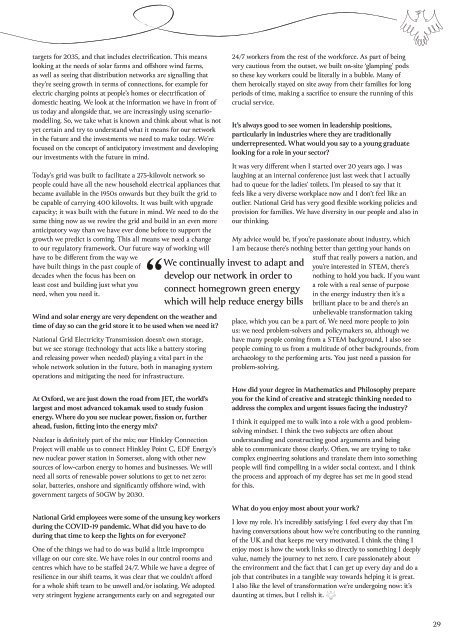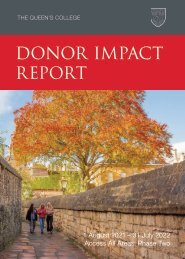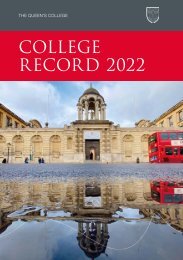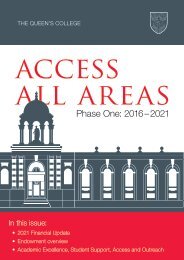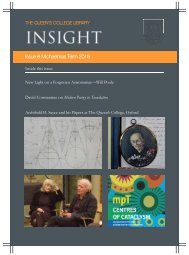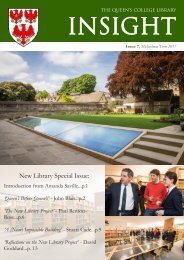Eagle Eye Magazine Issue 1 2023
Take a dive into the research and work that's going on at The Queen's College and beyond its walls within the community of Old Members. In issue one, we celebrate Shakespeare's First Folio, ask our history Fellows what makes them passionate about their subject, explore the new accessible Porters' Lodge, ask a current student about how to engage positively with climate issues, and much more.
Take a dive into the research and work that's going on at The Queen's College and beyond its walls within the community of Old Members. In issue one, we celebrate Shakespeare's First Folio, ask our history Fellows what makes them passionate about their subject, explore the new accessible Porters' Lodge, ask a current student about how to engage positively with climate issues, and much more.
You also want an ePaper? Increase the reach of your titles
YUMPU automatically turns print PDFs into web optimized ePapers that Google loves.
targets for 2035, and that includes electrification. This means<br />
looking at the needs of solar farms and offshore wind farms,<br />
as well as seeing that distribution networks are signalling that<br />
they’re seeing growth in terms of connections, for example for<br />
electric charging points at people’s homes or electrification of<br />
domestic heating. We look at the information we have in front of<br />
us today and alongside that, we are increasingly using scenariomodelling.<br />
So, we take what is known and think about what is not<br />
yet certain and try to understand what it means for our network<br />
in the future and the investments we need to make today. We’re<br />
focused on the concept of anticipatory investment and developing<br />
our investments with the future in mind.<br />
Today’s grid was built to facilitate a 275-kilovolt network so<br />
people could have all the new household electrical appliances that<br />
became available in the 1950s onwards but they built the grid to<br />
be capable of carrying 400 kilovolts. It was built with upgrade<br />
capacity; it was built with the future in mind. We need to do the<br />
same thing now as we rewire the grid and build in an even more<br />
anticipatory way than we have ever done before to support the<br />
growth we predict is coming. This all means we need a change<br />
to our regulatory framework. Our future way of working will<br />
have to be different from the way we<br />
have built things in the past couple of<br />
decades when the focus has been on<br />
least cost and building just what you<br />
need, when you need it.<br />
Wind and solar energy are very dependent on the weather and<br />
time of day so can the grid store it to be used when we need it?<br />
National Grid Electricity Transmission doesn’t own storage,<br />
but we see storage (technology that acts like a battery storing<br />
and releasing power when needed) playing a vital part in the<br />
whole network solution in the future, both in managing system<br />
operations and mitigating the need for infrastructure.<br />
At Oxford, we are just down the road from JET, the world’s<br />
largest and most advanced tokamak used to study fusion<br />
energy. Where do you see nuclear power, fission or, further<br />
ahead, fusion, fitting into the energy mix?<br />
Nuclear is definitely part of the mix; our Hinkley Connection<br />
Project will enable us to connect Hinkley Point C, EDF Energy’s<br />
new nuclear power station in Somerset, along with other new<br />
sources of low-carbon energy to homes and businesses. We will<br />
need all sorts of renewable power solutions to get to net zero:<br />
solar, batteries, onshore and significantly offshore wind, with<br />
government targets of 50GW by 2030.<br />
National Grid employees were some of the unsung key workers<br />
during the COVID-19 pandemic. What did you have to do<br />
during that time to keep the lights on for everyone?<br />
One of the things we had to do was build a little impromptu<br />
village on our core site. We have roles in our control rooms and<br />
centres which have to be staffed 24/7. While we have a degree of<br />
resilience in our shift teams, it was clear that we couldn’t afford<br />
for a whole shift team to be unwell and/or isolating. We adopted<br />
very stringent hygiene arrangements early on and segregated our<br />
“We continually invest to adapt and<br />
develop our network in order to<br />
connect homegrown green energy<br />
which will help reduce energy bills<br />
24/7 workers from the rest of the workforce. As part of being<br />
very cautious from the outset, we built on-site ‘glamping’ pods<br />
so these key workers could be literally in a bubble. Many of<br />
them heroically stayed on site away from their families for long<br />
periods of time, making a sacrifice to ensure the running of this<br />
crucial service.<br />
It’s always good to see women in leadership positions,<br />
particularly in industries where they are traditionally<br />
underrepresented. What would you say to a young graduate<br />
looking for a role in your sector?<br />
It was very different when I started over 20 years ago. I was<br />
laughing at an internal conference just last week that I actually<br />
had to queue for the ladies’ toilets. I’m pleased to say that it<br />
feels like a very diverse workplace now and I don’t feel like an<br />
outlier. National Grid has very good flexible working policies and<br />
provision for families. We have diversity in our people and also in<br />
our thinking.<br />
My advice would be, if you’re passionate about industry, which<br />
I am because there’s nothing better than getting your hands on<br />
stuff that really powers a nation, and<br />
you’re interested in STEM, there’s<br />
nothing to hold you back. If you want<br />
a role with a real sense of purpose<br />
in the energy industry then it’s a<br />
brilliant place to be and there’s an<br />
unbelievable transformation taking<br />
place, which you can be a part of. We need more people to join<br />
us: we need problem-solvers and policymakers so, although we<br />
have many people coming from a STEM background, I also see<br />
people coming to us from a multitude of other backgrounds, from<br />
archaeology to the performing arts. You just need a passion for<br />
problem-solving.<br />
How did your degree in Mathematics and Philosophy prepare<br />
you for the kind of creative and strategic thinking needed to<br />
address the complex and urgent issues facing the industry?<br />
I think it equipped me to walk into a role with a good problemsolving<br />
mindset. I think the two subjects are often about<br />
understanding and constructing good arguments and being<br />
able to communicate those clearly. Often, we are trying to take<br />
complex engineering solutions and translate them into something<br />
people will find compelling in a wider social context, and I think<br />
the process and approach of my degree has set me in good stead<br />
for this.<br />
What do you enjoy most about your work?<br />
I love my role. It’s incredibly satisfying: I feel every day that I’m<br />
having conversations about how we’re contributing to the running<br />
of the UK and that keeps me very motivated. I think the thing I<br />
enjoy most is how the work links so directly to something I deeply<br />
value, namely the journey to net zero. I care passionately about<br />
the environment and the fact that I can get up every day and do a<br />
job that contributes in a tangible way towards helping it is great.<br />
I also like the level of transformation we’re undergoing now: it’s<br />
daunting at times, but I relish it.<br />
29


